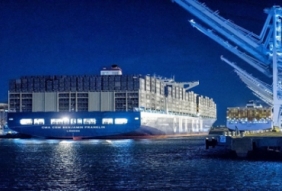
Posted on May 26, 2016
A new report by the Organisation for Economic Cooperation and Development predicts that trade in developing economies will grow around 1.5 times quicker than in developed economies.
The report Capacity to Grow: Transport Infrastructure Needs for Future Trade Growth states that hinterland connections will face the largest capacity challenges. These will be strained in Asia and Africa, in particular, where estimated traffic growth is highest and the limited availability of surface freight infrastructure is becoming an impediment to trade activity. The need to expand capacity will be particularly pertinent for infrastructure close to ports, and such infrastructure will need to almost triple in Asia and Africa by 2050 to provide the performance levels seen in 2010.
Global Trade
Growth in trade is expected to outpace GDP growth over the next 40 years, although at a lower scale than during pre-crisis decades. World trade is estimated to grow at around 3.5 percent annually compared with 6.9 percent over the period 1990-2007. The report suggests that container traffic related to international trade will double by 2030 while by 2050 the additional traffic will be nearly 300 percent of that today. This translates to over one billion TEU by 2030 and to nearly 2.2 billion TEU by 2050.
Looking at the traffic by 2030, the greatest increases in absolute terms are for Southeast Asia (143 million TEU), China (94 million TEU), North Asia (54 million TEU), Western Europe (52 million TEU) and South Asia (37 million TEU). In relative terms, the largest capacity increases would be needed in South Asia (193 percent), Southeast Asia (163 percent), North Africa (138 percent) and West Africa (137 percent).
By 2050, the North Pacific route will become the world’s busiest freight route with the biggest flow of goods. Significant growth will also take place in the Indian Ocean, the Mediterranean and the Caspian Sea corridors. Inland connections will also grow strongly, with freight volumes in intra-Asian trade multiplying by nearly seven times between 2010 and 2050.
Competition and Funding
New maritime trade growth creates the need for more port capacity which could be provided by new actors, generating more competitive pressures for existing ports. It has become common practice to use port expansions as a way of increasing intra-port competition and introduce more cargo handling services. However, too much competition in a sluggish market could lead to terminal overcapacity.
This has been the case in Europe. The average utilisation rate of container terminals in 2014 globally was 67.6 percent. This rate is considerably lower in all parts of Europe: 50.5 percent in Scandinavia and Baltic, 56.4 percent in Northwest Europe, 61.3 percent in East Mediterranean & Black Sea, and 62.7 percent in West Mediterranean.
As a result, cargo volumes fell well short of minimum efficiency. There is competition but not enough cargo, and some terminals could be obliged to suspend operations.
Strategic planning is needed to find the right balance between terminal under-capacity and over-capacity. Various countries, such as Canada, France and India, have established a national port hierarchy. They define a port system in which some ports are of “national importance” whereas other ports are of local importance.
Port Hierarchies
Both China and the E.U. have strategic visions that could change the port hierarchies of different continents. Two important initiatives to build up alternative port capacities include the Trans-European transport network (TEN-T) of the E.U. and China’s One Road One Belt network.
The consequences for Europe could be a counter-weight to the dominance of North European ports. Also in other continents, this could mean the establishment of a parallel (or partly parallel) network. For example, under the One Road One Belt initiative, the role of Singapore as a Southeast Asian hub seems to be supplemented by Malaysia and Indonesia.
Ever Larger Ships
Over the last two decades, container ships have quadrupled in size. The economies of scale are diminishing as the size of container ships increases, but there will still be some economies of scale to be reaped from even larger ships.
The cost savings of larger ships are offset by the costs to the whole transport chain. These costs are not internalised by shipowners. It could happen though if the necessary port and terminal investments translate into higher port and terminal charges for big ships, if dredging costs need to be covered by shipping lines or if insurance premiums for the largest ships substantially rise due to the higher system risks that they represent.
The report is available here.
Source: The Maritime Executive





